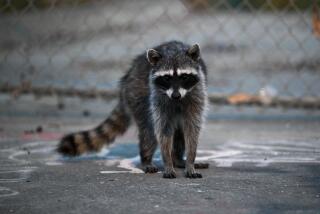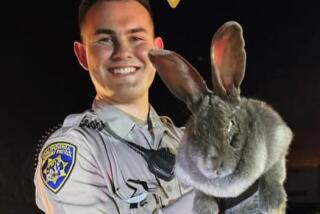Amid the human coronavirus pandemic, a deadly disease strikes rabbit populations
- Share via
SAN DIEGO — A lethal disease that strikes rabbits has been detected in a jackrabbit in Palm Springs, leading veterinarians and animal rescue organizations to prepare for its potential spread to San Diego County and throughout the state.
The disease, rabbit hemorrhagic disease virus, is highly contagious and can jump between wild and domestic populations. It hit California for the first time in early May, when a group of about 10 dead rabbits were found in Palm Springs, and tests of one of the carcasses came back positive for the virus.
With a fatality rate as high as 80%, the disease can decimate colonies of rabbits, jackrabbits, pika and hare, but it does not affect humans or other animals, including cats or dogs. Pets, scavengers and other animals can spread the virus on their feet or fur, however, so officials are taking steps to protect rescued rabbits and urging rabbit owners to safeguard their pets.
“It spreads very fast in the wild populations,” said Jon Enyart, director of wildlife medicine for Project Wildlife, the rescue arm of the San Diego Humane Society. “Then it runs rampant through the domestic populations as well.”
The disease has circulated for several decades throughout 40 countries in Asia, Europe, Africa and Australia, as well as Mexico and Canada. A second strain emerged in France in 2010, and in March of this year it began killing both wild and domestic rabbits in New Mexico, Colorado, Arizona, Texas and Mexico, according to the California Department of Fish and Wildlife.
That’s when officials braced for a possible outbreak in California.
“It’s a really hard virus to contain, once it’s out in a wild landscape,” said Deana Clifford, a senior wildlife veterinarian with the California Department of Fish and Wildlife. “There’s no way to really effectively protect wild rabbits in the state.”
Wildlife officials are monitoring rabbit populations and collecting samples, officials said. And they are examining animals that appear to have died of the disease, selectively testing carcasses to determine if the virus is spreading to new areas or different species, such as cottontails or other rabbit relatives, Clifford said.
Studies from outbreaks in Europe show that the death rate of infected rabbits ranges from 5% to 80%, she said. So it’s possible that wild populations may rebound from the epidemic, even if it spreads.
“What we hope is that over time ... some rabbits will survive and develop some resistance,” Clifford said.
In the meantime, the risk to both wild rabbits and pets exposed to the virus is high. The disease is in a group called calicivirus and is unrelated to the novel coronavirus that causes COVID-19.
To rabbits, however, it’s not only far more lethal than the coronavirus but also much hardier. It can remain viable in the environment at room temperature for 105 days, and even longer — 225 days — at 39 degrees Fahrenheit, according to a statement by the House Rabbit Society. It’s not killed by freezing, and infected rabbits who survive can shed the virus for 42 days or longer.
The virus hasn’t appeared among any rabbits in San Diego, but rescue workers are taking precautions anyway. The San Diego Chapter of the House Rabbit Society, an all-rabbit rescue organization, is isolating new animals at their shelter and warning rabbit owners to be careful with their pets.
“We as humans can spread the virus too, on shoes or carpets,” said Jennifer Lee, executive director of the San Diego House Rabbit Society. “That’s why it’s important that people who have rabbits, not have their rabbits go outside to play, and have inside shoes, and outside shoes, and clothing.... If they feel that their rabbit might have it, isolate that rabbit, especially if you have other rabbits in their home.”
Other recommendations include washing hands before and after handling a pet rabbit; changing clothes after contacting other rabbits; disinfecting shoes with bleach; using only known hay and feed sources and avoiding foraged plants, grasses or tree branches; installing door and window screens to eliminate flies and mosquitoes; and quarantining any new rabbit.
The virus causes liver inflammation and prevents blood from clotting, said Linda Knox, a veterinarian at Palomar Animal Hospital. A vaccine available in Europe can protect rabbits from the disease, but it’s not approved for widespread use in the U.S. Veterinarians can apply to use it only once a case is confirmed in their own state. So after the Palm Springs carcass tested positive, Knox applied for access to the vaccine.
“We are trying to get emergency approval through the [U.S. Department of Agriculture] to import this vaccine, Eravac, which is made in Spain,” she said. “Once we get the USDA approval, we hope to get this vaccine imported so we can protect the rabbits.”
She expects the vaccine to arrive about a month after she receives approval. Once it does, it could be administered to pet or rescue rabbits. It would not be possible to vaccinate wild rabbits, Clifford said.
But some very rare, endangered species — such as the riparian brush rabbit in the Central Valley, which numbers only a few hundred — could potentially be captured and vaccinated if the disease strikes its area, she said.
Signs of infection can include low appetite, lethargy, fever, seizures or bleeding from the nose, mouth or rectum. But there may also be no symptoms until sudden death, so shelters, as well as pet owners, must separate new rabbits from others for a quarantine period.
At Project Wildlife, which takes in 12,000 sick, injured or orphaned wild animals a year, including up to 2,000 rabbits, that’s a big challenge, Enyart said. But workers are placing new animals or groups of animals in quarantine rooms, and assigning staff members to specific rooms so they don’t cross-contaminate other groups.
Amid the COVID-19 pandemic, rescue workers have already adopted practices such as social distancing, wearing masks and gloves, and changing clothes before and after working with animals, officials said. The rabbit epidemic has reinforced and refined those practices, officials said.
“I do feel like [COVID-19] has prepared us for this, because we were already in the mind-set,” Enyart said. “We’re finding that in the midst of all this madness, that best practices are getting better. We’re able to say these rabbits can’t be near these rabbits, that helps us see if there are any concerns with our own [personal protective equipment] and our own biosecurity. So it’s really helping us fine-tune it and make it as good as possible.”
Brennan writes for the San Diego Union-Tribune.
More to Read
Sign up for Essential California
The most important California stories and recommendations in your inbox every morning.
You may occasionally receive promotional content from the Los Angeles Times.











